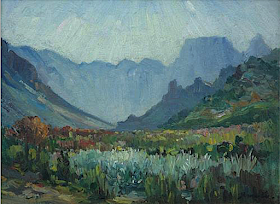HUGO NAUDÉ (1869-1938)
Du Toits Peak (1,995 m - 6,545 ft)
South Africa
The mountain
Du Toits Peak (1,995 m - 6,545 ft) is the highest seaward facing peak in the Cape Fold Belt ranges, i.e. the highest peak in the Western Cape within direct sight of the ocean. Located between Paarl and Worcester in the south-west of South Africa, 70 kilometres (43 mi) to the north-east of the provincial capital of Cape Town. The mountains form a formidable barrier between Cape Town and the rest of Africa on the N1 highway, also called the Cape to Cairo Road. This section is called the Du Toitskloof Pass. The old route culminates at 820 metres (2,690 ft), however, the new Huguenot Tunnel, of 4.4 kilometres (2.7 mi) in length, cuts out the old mountain pass.
The range mostly consists of Table Mountain sandstone, an erosion-resistant quatzitic sandstone. Vegetation is almost exclusively montane fynbos of the Cape floristic region. The rest of the mountains are barren rocks and steep cliffs. Precipitation occurs primarily in the winter months as rain on the lower slopes and as snow higher up, usually above 1000m. Climate varies dramatically, with the surrounding valleys being up to 10°C (18°F) warmer than the mountains. The climate falls within the Mediterranean type. The mountains form part of the Cape Syntaxis, a complex portion of the Cape Fold Belt where the north-south trending ranges meet in the east-west trending ranges in a complex series of folds, thrusts and fault-lines.
The painter
Hugo Naudé was South Africa’s pioneer impressionist painter. He received his professional art education at the Slade School of Fine Art in London (1889 -1890) and the Kunst Akademie in Munich (1890 -1894) and spent a year amongst the Barbizon painters in Fontainebleau near Paris.
Born and raised in the Boland town of Worcester, Naudé became South Africa’s first professional artist, establishing “Cape Impressionism”, an adaptation of European Impressionism, in conjunction with the artists Pieter Wenning, Nita Spilhaus, Ruth Prowse and Strat Caldecott. After his European training, Naudé had to adapt to the sunlit brilliance of the African landscape and as “plein-airste” gradually loosened the bonds of his formal training - pioneering a truly South African style which has been maintained by a second and third generation of artists.
When Hugo Naudé returned to South Africa in 1896, after 6 years of formal art training and study in Europe (1889-1895) he initially tried to establish himself as a portrait painter for which he had received expert training from the great Franz von Lenbach in Munich. The prevailing artistic climate proved this idea to have been too optimistic, and thus began a gradual transition in subject matter from portrait to landscape.
